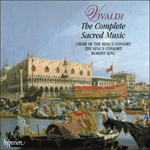
Welcome to Hyperion Records, a British classical label devoted to presenting high-quality recordings of music of all styles and from all periods from the twelfth century to the twenty-first.
Hyperion offers both CDs, and downloads in a number of formats. The site is also available in several languages.
Please use the dropdown buttons to set your preferred options, or use the checkbox to accept the defaults.

Padua was the Republic of Venice’s ‘second city’ and the seat of its university. When the Venetian nobility went, for their summer vacation, to their country seats on the mainland, they often travelled via Padua, attending the basilica’s patronal festival on the way. Vivaldi was very familiar with this ceremony, since both he, and before him his father, were on several occasions recruited to the orchestra that participated in it. Indeed, in 1712 he wrote a violin concerto for the feast (RV212) in which he himself took the solo part.
The opening aria depicts the gentle wafting of the breezes in terms familiar to those who remember the first movement of Vivaldi’s ‘Spring’ Concerto from The Four Seasons, testing the vocal soloist’s virtuosity. The recitative focuses on the miraculous tongue of the saint, uncorrupted even after his death. A second aria calls on the whole of nature to recount Antony’s deeds, and an exuberant, concerto-like ‘Alleluia’ rounds off the work.
from notes by Michael Talbot © 2003
Deuxième ville de la République de Venise, Padoue était aussi le siège de son université. Lorsque la noblesse vénitienne partait pour ses résidences estivales, quittant la lagune pour la campagne, elle s’arrêtait souvent à Padoue en chemin pour assister à la fête du patron de la Basilique. Vivaldi connaissait très bien cette cérémonie puisque, comme son père avant lui, il avait à plusieurs occasions été recruté dans l’orchestre qui y participait. En 1712, il avait même écrit pour cette fête un concerto pour violon (RV212) où il tenait la partie de soliste.
Mettant à l’épreuve la virtuosité du soliste, l’aria initiale dépeint le doux entrefilet d’air de la brise en des termes familiers pour ceux qui se souviennent du premier mouvement du Concerto « Le Printemps » de ses Quatre Saisons. Le récitatif se concentre sur la langue miraculeuse du saint, qui ne fut pas corrompue, même après sa mort. La seconde aria fait appel à la nature tout entière pour évoquer les actions de saint Antoine. Un Alléluia exubérant aux allures de concerto conclut cette œuvre avec brio.
extrait des notes rédigées par Michael Talbot © 2003
Français: Isabelle Battioni
Padua war als Universitätssitz die „zweite Großstadt“ der venezianischen Republik. Wenn sich der venezianische Adel im Sommer auf seine Landsitze auf dem Festland zurückzog, reiste er oft über Padua und besuchte dann das Fest des Patrons der Basilika. Vivaldi war mit dieser Zeremonie gut vertraut, da er, und vor ihm sein Vater, zu diversen Gelegenheiten für das Orchester angeheuert worden war, das bei der Feier mitwirkte. Tatsächlich schrieb er im Jahre 1712 ein Violinkonzert (RV 212) für das Fest, bei dessen Aufführung er den Solopart selbst übernahm.
Der für die Vokalsolistin virtuose Anfang der Arie stellt den leichten Lufthauch einer Brise dar und erinnert im Stil an den ersten Satz des „Frühlings“ aus den „Vier Jahreszeiten“ von Vivaldi. Im Rezitativ wird auf die wundersame Zunge des Heiligen eingegangen, die selbst nach dessen Tod unverdorben bleibt. In einer zweiten Arie wird die gesamte Natur angerufen, um Antonius’ gute Taten nachzuerzählen und mit einem übersprudelnden „Alleluia“ wird das Werk abgerundet.
aus dem Begleittext von Michael Talbot © 2003
Deutsch: Viola Scheffel
 Vivaldi: The Complete Sacred Music Vivaldi: The Complete Sacred Music‘For King's sterling service to the Vivaldian cause, one of his most important recording and satisfying projects to date, I am thankful’ (Gramophone) ‘If you're waiting for the perfect collection of Vivaldi's sacred music, this is it. It was a happy day when this beautiful boxed set arrived in my m ...» More |

